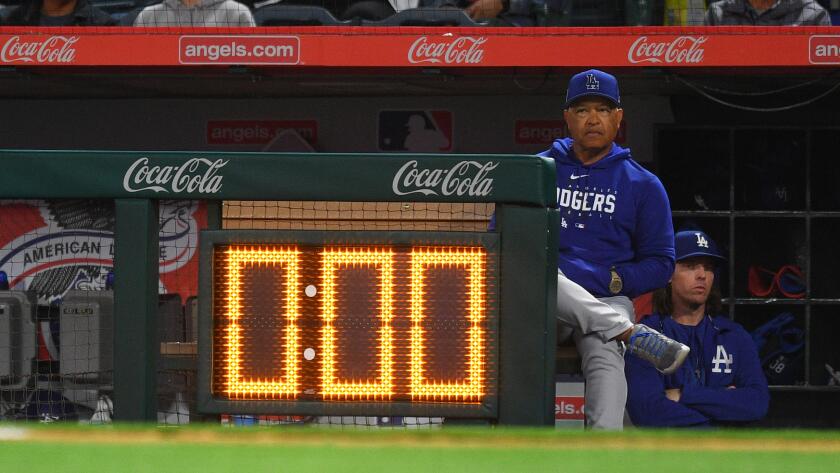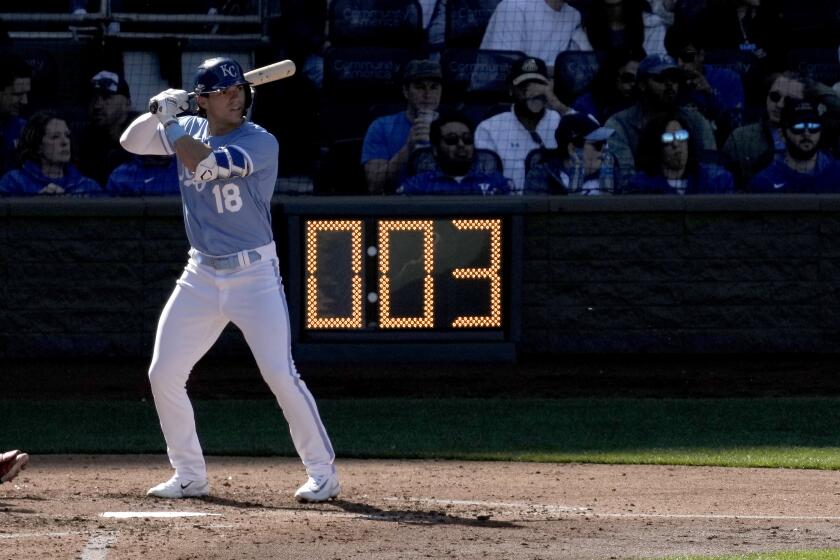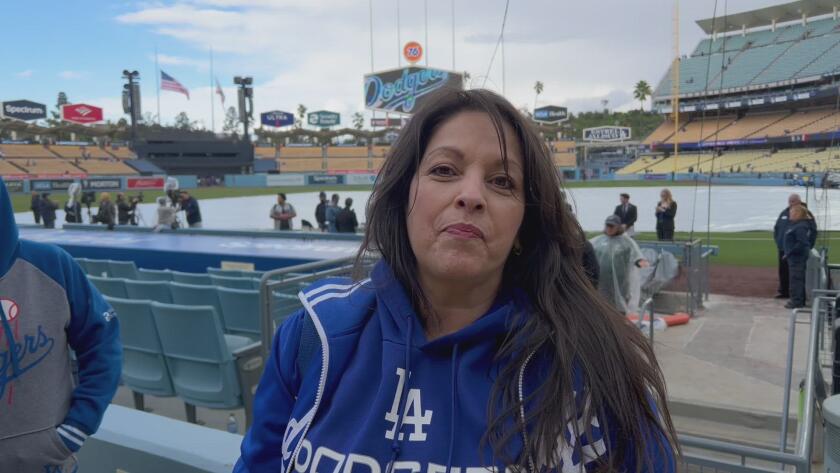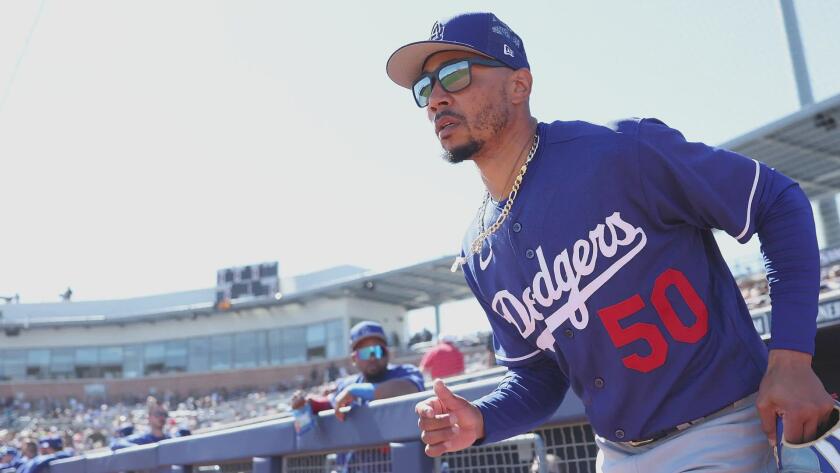Falling in love with the pitch clock is easy. Time to embrace baseball’s new reality
- Share via
- Share via
Two minutes, one out! One minute, two outs! Two minutes, three outs!
Batter up, batter down, batter up, batter down, batter up, batter down.
Groundoutflyoutflyout.
So went the accounting of the first half-inning of the Dodgers’ game Friday night against the Arizona Diamondbacks, a shining example of baseball’s greatest new look since the invention of bubble gum.
I love the pitch clock.
The half-inning lasted all of five minutes. The Dodgers’ Dustin May was swiftly dealing. The Diamondbacks hitters were harried and hustling. It was fast. It was furious. It was fun.
I adore the pitch clock.
It’s baseball on legal steroids. It’s baseball’s ancient board game become today’s video game. It’s the coolest thing to happen to baseball since the debut of eye black. It’s the first time baseball has prioritized the comfort of the fans over the comfort of players in … forever.
The Dodgers cruise to a 10-1 win over the Arizona Diamondbacks after Trayce Thompson hits a grand slam, a three-run blast and a solo home run.
I am so enamored with the pitch clock I want to take one home so I can quicken the pace of my breakfast.
You know the new rules. Pitchers have 15 seconds to throw the ball, 20 seconds with a runner on base, while batters must be engaged with the pitcher by the eight-second mark. A ball for pitching violations, a strike for batter violations.
You’ve seen the stats. The average time for this season’s opening-day game was 2:45, which is 26 minutes shorter than last year.
Now embrace the reality. Baseball has essentially cut out 30 minutes of pitchers stepping off the mound to fiddle with their grip and batters stepping out of the box to adjust their gloves in an elaborate game of chicken that wastes everyone’s time. Baseball has essentially opened its doors to casual fans who have long ignored the sport because it was too plodding and slow. Once on the verge of irrelevancy compared to football and basketball, baseball might have just saved itself.
Did I tell you I loved the pitch clock?
I’m not the only one.
“It’s great,” marveled Dodgers manager Dave Roberts after a speedy opening night Thursday. “That was front of mind, actually, looking at the game, ‘Man we played it in 2:35 tonight, last year we played it in 3:35,’ it’s just not that much of a grind.”
Technically, last year’s opener in Colorado required 3:09, but you get the picture. These games are so fast paced, they seem like an hour shorter, and, in this case, less is more.
It was such a different experience at Dodger Stadium during the season’s first two nights, the place almost felt like Crypto.com Arena. Fans were cheering or booing something seemingly every five minutes. The “Let’s Go Dodgers” chants lasted only about two verses before the pitcher was working again. Despite huge crowds, the concourses didn’t feel crowded perhaps because people didn’t want to leave their seats.
Major League Baseball’s new pitch clock rules will go into effect for real Thursday when the regular season begins. Players say it’s time to focus.
And that cliché about Dodger fans always departing in the seventh inning? Kiss it goodbye. Judging from an unofficial eye test, the vast majority of fans stayed until the end of the game because the games just didn’t end that late.
Stan Brooks has had season tickets in his family for 59 years, and opening night was a revelation.
“It’s the first time I’ve gotten to my Westside home after a night game before 11,” he said. “Loved the pace of the game, just loved it. I don’t need to sit there for an extra hour watching guys adjust their jock straps. It’s the best change in baseball since I started watching baseball.”
Standing in a concession line during the Dodgers’ second game Friday, longtime fan Don Mejia marveled at how that pitch clock has literally changed the conversation.
“You’re not sitting there saying, ‘Oh my God, this is taking forever, will you please pitch the ball?’” he said. “The game is more fun. It dragged, and now it doesn’t drag.”
The game is equally improved for television. Before this season I can’t remember the last time I watched an entire baseball game on TV. They took too long. Who has four hours to invest in a bunch of guys standing around? Yet I watched one full game this spring, and it felt like I barely sat down.
“The thing I noticed the most was there was not much time to get up during an inning to get something to eat or go to the bathroom,” said longtime fan Drew Pomerance, who watched the opener on TV. “I had to wait till between innings, because the innings themselves moved at a much quicker pace.”
Not everyone loves it. So far, the players are just enduring it. They say it’s hard to get comfortable. They worry about rushing into an injury. Attempting to play this most difficult sport in front of thousands of screaming fans, they wish they still had a chance to push the pause button.
- Share via
Dodgers fans share their opinions on the pitch clock and whether it makes the game better or not.
Starting pitchers have gone from playing a leisurely game of catch to an intense game of ping-pong. In Julio Urías’ first inning of the season opener, he gave up two runs in about three minutes before he finally adjusted.
“It’s just different,” said the Dodgers’ ace. “As a starting pitcher you had the opportunity to take a breath and relax and be at your own pace. With the pitch clock you don’t have those opportunities.”
Batters, meanwhile, have gone from taking calming breaks to forcing themselves immediately into the fire. In the eighth inning Friday night, with runners on first and second and two out in a one-run game, Dodgers shortstop Miguel Rojas hastily swung at Scott McGough’s second pitch and lined out to end the potential rally in an eventual 2-1 Dodgers loss.
“The pitch clock is hard,” said Rojas. “In the eighth inning I feel like I needed a little bit more time, to be honest with you. These games are going to be more intense and you’re going to need to get a little more time. Hopefully nobody gets hurt.”
- Share via
The Los Angeles Dodgers bring a vastly new look to the field for the 2023 season. Beat reporter Jack Harris and sports columnist Bill Plaschke talk about the upcoming season and how well the Dodgers might do.
Rojas admitted, however, that it’s good for the fielders, as it keeps them more engaged.
“As fielder, it’s much better, not standing on your feet a lot, it’s a good way to get the game moving,” he said. “But we have to understand hitters and pitchers need a little more time to gather themselves. It’s not that easy to hit, it’s hard to pitch, and to be rushing … ”
The pitch clock has even changed the way Dodger Stadium looks. There are five clocks located around the field, with most fans focusing on two giant clocks looming above the outfield fence. The clocks are manually started and stopped by a major-league employee sitting in a booth at the top of the loge seats behind home plate.
“Just like in the NBA you have a clock operator, and in the NFL you have a clock operator, now major league baseball has a clock operator,” said Joe Martinez, MLB vice president for on-field strategy, who was at Dodger Stadium for the opening games.
Martinez said the clock was instituted at the behest of fans who overwhelmingly wanted more action.
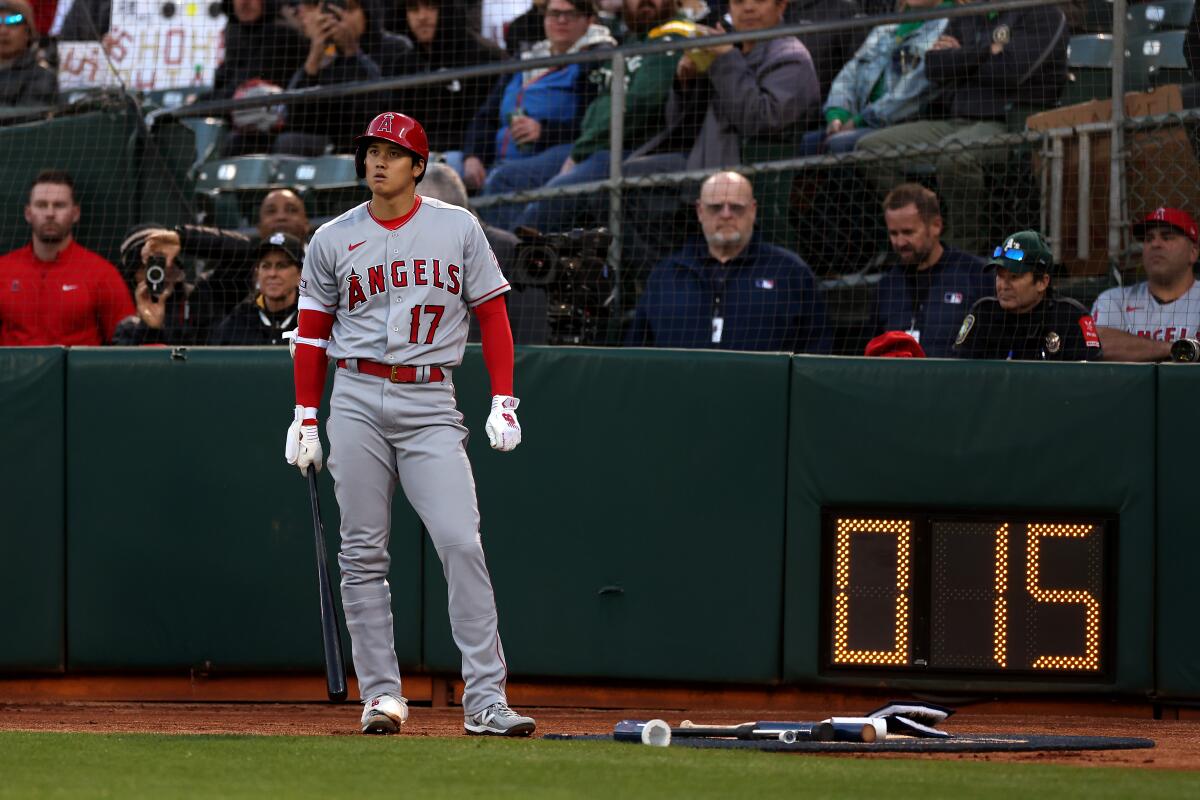
“It’s cut out a lot of dead time, there’s not a lot of waiting around, it’s what fans say they want,” he said.
There are still critics who think the pitch clock, which was previously tested in the minor leagues, is being pushed by a deadline-oppressed media that doesn’t want to work as long. Those critics claim that with soaring ticket prices, fans want to spend more time at the ballpark, not less.
“But you still get your money’s worth,” said Martinez. “We’re not cutting out the part that you’re paying for, we’re cutting out the part where nothing’s happening.”
These days, it’s everything everywhere all at once. In two nights at Dodger Stadium I saw a four-minute inning, I heard fans gleefully counting down for opposing pitchers, and I felt a long-dormant game come to life again.
I love the pitch clock.
More to Read
Are you a true-blue fan?
Get our Dodgers Dugout newsletter for insights, news and much more.
You may occasionally receive promotional content from the Los Angeles Times.
